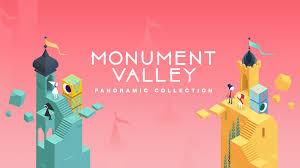
Monument Valley stands out in the puzzle genre due to its unique combination of artistic design and innovative puzzle mechanics. The game challenges players not just to solve puzzles but to do so within a world of impossible geometry inspired by the works of M.C. Escher. This interplay between art and gameplay creates a meditative experience that sets Monument Valley apart from other puzzle games. A standout moment in Monument Valley is the first time a player successfully manipulates an impossible object to create a new path for Princess Ida. This “aha” moment, where the player’s understanding of the game’s mechanics clicks into place, is a testament to the game’s design brilliance. The satisfaction derived from solving these puzzles, combined with the serene and visually stunning environments, creates a memorable gaming experience.
Visual and Gameplay Innovations
Monument Valley’s most striking feature is its visual design. The game presents a series of beautifully crafted, surreal landscapes that players must navigate by manipulating the architecture itself. This manipulation often involves altering the perspective to create new pathways, leveraging optical illusions and impossible objects. For example, in one level, players must rotate parts of the structure to connect disjointed paths, effectively creating walkable surfaces where none existed before. This mechanic is both intuitive and mind-bending, pushing players to think outside traditional puzzle-solving frameworks. The clever use of perspective and geometry is reminiscent of games like Echochrome but taken to a new level of polish and artistic refinement.
Comparisons and Differentiation
Compared to other puzzle games, Monument Valley’s emphasis on visual storytelling and atmosphere is unparalleled. While games like Portal and The Witness offer intricate puzzles and deep narratives, Monument Valley excels in creating an emotional connection through its art and simplicity. The story of Princess Ida’s journey, though minimalistic, is conveyed through the environment and player interactions, making it deeply personal and impactful.
However, Monument Valley is not without its flaws. The game’s relatively short length and limited difficulty curve can leave experienced puzzle gamers wanting more. While its sequel, Monument Valley 2, addresses some of these concerns by introducing new mechanics and a more complex narrative, the core experience remains one of elegant simplicity, which might not satisfy players looking for a more prolonged or challenging experience.
To enhance its appeal, Monument Valley could introduce a level editor, allowing players to create and share their puzzles. This would not only extend the game’s lifespan but also foster a community of creators and solvers, similar to what has been seen with games like LittleBigPlanet. Additionally, incorporating more narrative depth or branching storylines could provide a richer, more engaging experience for those who seek a deeper connection with the game’s world and characters.
Integration and Analysis
By analyzing Monument Valley through the lens of game design principles and comparing it to other titles in the genre, we can appreciate its unique contributions and potential areas for growth. Monument Valley exemplifies key formal elements and concepts from the Mechanics, Dynamics, and Aesthetics (MDA) framework. The mechanics of perspective manipulation and pathfinding create a dynamic that encourages exploration and experimentation. The aesthetics of the game—its visual style, sound design, and emotional tone—create an experience that is both soothing and intellectually stimulating.
From a formal elements perspective, Monument Valley uses space and player movement in innovative ways. The space is not just a backdrop but an active participant in the puzzle-solving process. Player movement is fluid and satisfying, with each interaction thoughtfully designed to be both functional and beautiful.
Monument Valley’s blend of artistic design and innovative gameplay mechanics sets it apart in the puzzle genre. Its unique approach to perspective and geometry challenges players to think differently, creating a meditative and aesthetically pleasing experience. While it may benefit from more content and complexity, its core experience remains a testament to the potential of games as an art form. For those seeking a beautiful and thought-provoking journey, Monument Valley offers an unforgettable adventure through its impossible worlds. This game is not just a puzzle to be solved but a piece of interactive art to be experienced.



